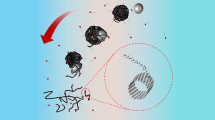Abstract
Four kinds of polyvinyl pyrrolidone (PVP) with various molecular weights (Mw: 111, 8000, 40000, and 630000) were investigated in this work for their ability to disperse sub-micron nickel particles synthesized by chemical reduction of NiCl2 with hydrazine hydrate. Our results indicate that dispersion of the resultant nickel particles was significantly dependent on the molecular weights of PVP, and all the resultant nickel particles were composed of many nanometer-sized nickel crystallites. Using NVP (Mw = 111) or PVPk90 (Mw = 630,000) as dispersant, nickel particles seriously aggregate. PVPk30 (Mw = 40,000) is the most effective dispersant. Nickel particles synthesized with PVPK30 as dispersant show perfect dispersion status, owing to the fact that polyethylene main chains of PVPk30 bonded on the surface of nickel particles could offer good protection against agglomeration of nickel particles. In comparison with other obtained nickel powders, nickel powders synthesized with PVPk30 as dispersant show excellent electrical conductive property in the nickel powder/epoxy composite.






Similar content being viewed by others
References
Srinivasa RK, Balaji T, Lingappa Y, Ravi PRM, Prakash TL (2012) Chemical synthesis and magnetic properties of HCP and FCC nickel nanoparticles. Phase Transit 85:235–243
Hemalatha M, Suryanarayanan N, Prabahar S (2014) Synthesis and characterization of nickel nanoparticles by chemical reduction method. J Optoelectron Adv Mate 8:288–291
Cheng Q, Wu C, Wu K et al (2011) Electrochemical tuning the activity of nickel nanoparticle and application in sensitive detection of chemical oxygen demand. J Phys Chem C 24:22845–22850
Jin Y, Lin B, Rollett AD et al (2015) Thermo-mechanical factors influencing annealing twin development in nickel during recrystallization. J Mater Sci. doi:10.007/s10853-015-9067-0
Han M, Liu Q, He JH, Song Y et al (2007) Controllable synthesis and magnetic properties of cubic and hexagonal phasem nickel nanocrystals. J Adv Mater 19:1096–1100
Tzitios V, Basina G, Gjoka M, Petridis D (2006) Chemical synthesis and characterization of hcp Ni nanoparticles. J Nanotechnol 17:3750–3755
Nouneh K, Bousmina M, Oyama M et al (2011) Nano-sized synthesis and optical features of metallic nickel nanoparticles by wet chemical approaches. J Alloy Compd 509:5882–5886
Lin SW, Chang SC, Liu RS et al (2004) Fabrication and magnetic properties of nickel nanowires. J Magn Magn Mater 282:28–31
Pan H, Liu BH, Yi JB et al (2005) Growth of single-crystalline Ni and Co nanowires via electrochemical deposition and their magnetic properties. J Phys Chem B 109:3094–3098
Luo Y, Zhang JC, Shen Y et al (2006) Preparation and magnetic properties of nickel nanorods by thermal decomposition reducing methods. Trans Nonferrous Met Soc 16:96–100
Singjai P, Wongwigkarn K, Laosiritaworn K, Yimnirun R, Maensiri S (2007) Carbon encapsulated nickel nanoparticles synthesized by a modified alcohol catalytic chemical vapor deposition method. Curr Appl Phys 7:662–666
Liu D, Ren S, Wu H, Zhang Q (2008) Morphology control in synthesis of nickel nanoparticles in the presence of polyvinylpyrrolidone (PVPK30). J Mater Sci 43:1974–1978. doi:10.1007/s10853-008-2459-7
Huang GY, Xu SM, Li LY, Wang XJ (2014) Effect of surfactants on dispersion property and morphology of nano-sized nickel powders. Trans Nonferrous Met Soc 24:3739–3746
Kwang HK, Yoon BL, Eun YC, Hee CP, Seong SP (2004) Synthesis of nickel powders from various aqueous media through chemical reduction method. Mater Chem Phys 86:420–424
Wang HS, Qiao XL, Chen JG, Wang XJ, Ding SY (2005) Mechanisms of PVP in the preparation of silver nanoparticles. Mater Chem Phys 94:449–453
Liu D, Ren S, Wang G, Yu J (2009) Rapid synthesis and morphology control of nickel powders via a microwave-assisted chemical reduction method. J Mater Sci 44:108–113. doi:10.1007/s10853-008-3116-x
Neiva EGC, Bergamini MF et al (2014) PVP-capped nickel nanoparticles: synthesis, characterization and utilization as a glycerol electrosensor. Sens Actuator B 196:574–581
Saidi WA, Feng H, Fichthorn KA (2013) Binding of polyvinylpyrrolidone to Ag surfaces: insight into a structure-directing agent from dispersion-corrected density functional theory. J Phys Chem C 117:1163–1171
Li YD, Li CW, Wang HR et al (1999) Preparation of nickel ultrafine powder and crystalline film by chemical control reduction. Mater Chem Phys 59:88–90
Acknowledgements
This research was supported by the Science & Technology project of Guangdong Province (Grant No. 2KB02501G), China.
Author information
Authors and Affiliations
Corresponding author
Rights and permissions
About this article
Cite this article
Liu, D., Lin, L., Ren, S. et al. Effect of polyvinyl pyrrolidone (PVP) molecular weights on dispersion of sub-micron nickel particles by chemical reduction process. J Mater Sci 51, 3111–3117 (2016). https://doi.org/10.1007/s10853-015-9620-x
Received:
Accepted:
Published:
Issue Date:
DOI: https://doi.org/10.1007/s10853-015-9620-x




